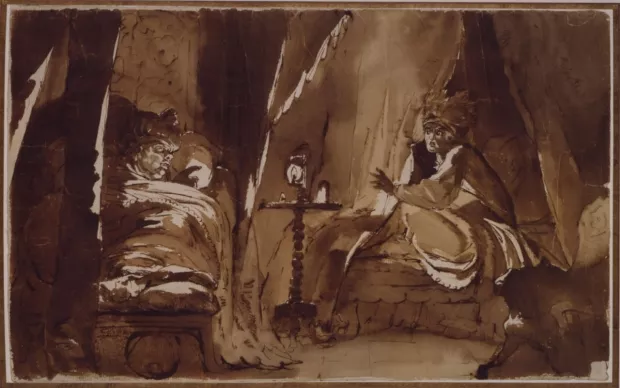Creation Date
1765
Height
21 cm
Width
33 cm
Medium
Genre
Description
Henry Fuseli is known for his grotesque, eerie images, especially The Nightmare, which he painted in 1781 (Fuseli 64). In Midnight, a much earlier work, he creates a contrast between light and darkness that is reminiscent of the spectacle shows of the Romantic era. One can almost imagine the candle in the center, casting silhouettes on the walls, to be a magic lantern. The person on the right appears frightened, as though he has just woken from a bad dream, but the image itself is also nightmarish. The deep shadows make the room and the face of his companion strange—the familiar becomes the grotesque, exemplifying Freud’s idea of the uncanny. It is this concept of the strangeness in the ordinary that makes Gothic art and literature so frightening. Many Gothic writers leave the reader wondering whether a figure is a person or an automaton, while painters like Fuseli blur the distinction between human and monster (Freud 227).
Midnight was created early in Fuseli’s career, soon after he left his native Zurich both to study art and to escape the consequences of a politically charged, satirical pamphlet he and a few of his classmates published in 1763 (Fuseli 21). He traveled through Germany, England, and France before eventually settling in England. Fuseli was pursuing a literary career when he painted Midnight (he revised some of the Iliad later in life), and he did not become a professional artist until after 1768 (Fuseli 62-67).
Two canopied beds lie perpendicular to one another in a small room. A candle on the table between them illumines the room. A portly figure lies in the bed on the left and points toward the figure sitting up in the bed opposite, a younger person who clutches the curtain in an attitude of trepidation. The play of light and shadow in this image renders the familiar unfamiliar, and, in the subsequent appeal to the Gothic, demonstrates yet another form in which the Romantic fascination with the marvelous manifested itself.
Locations Description
Henry Fuseli (1741–1825) painted this image in England after he was forced to flee Zurich in 1763. Zurich is the largest city in Switzerland.
Copyright
Copyright, 2009, Romantic Circles.
Collection
Accession Number
1971.66.3
Additional Information
Bibliography
Freud, Sigmund. "The Uncanny." The Standard Edition of the Complete Psychological Works. Trans. James Strachey. Vol. XVII. London: Hogarth P, 1955. 218-52. Print.
Fuseli, Henry. The Life and Writings of Henry Fuseli. Ed. John Knowles. Vol. 1. London, 1831. Internet Archive. Web. 21 Mar. 2009
"Fuseli: The Nightmare." Mark Harden's Artchive. n.p., n.d. Web. 28 Mar. 2009.
Fuseli, Henry. "Midnight." 1765. National Gallery of Art. Washington, D.C. National Gallery of Art. Web. 21 Mar. 2009.

